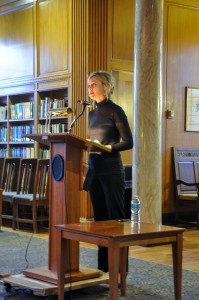Poet and biologist Katherine Larson read from her book “Radial Symmetry,” a collection of poems, in the University’s Plutzik Reading Series on Tuesday evening. The Plutzik Reading Series welcomes luminary literary and poetic writers to read their work to the public, free of charge.
Larson’s first book, “Radial Symmetry,” was selected by distinguished poet Louis Glück as the winner of the Yale Series of Younger Poets in 2011. A molecular biologist and ecologist, Larson stands out among American poets because of her unique approach to poetry–her poems are infused with her scientific inquiry and laboratory research. From segments of Charles Darwin’s lost Galapagos Island notebooks to descriptions of branchial hearts, Larson’s analysis and biological insights influence her poetry.
The book’s title, “Radial Symmetry,” has dual meanings. While the title refers to the kind of biological symmetry found in some marine organisms, it also refers to symmetry as a compositional principle in art.
“An invertebrate zoologist once told me, ‘The point of radial symmetry is to have the capacity to approach the environment from any angle or side.’” Larson said. “I feel that working as both a scientist and a poet has allowed me just that opportunity.”
Larson began by introducing her approach to writing “Radial Symmetry.”
“I take biological terms and examine them through the lens of human experience,” She explained. During the reading, Larson revealed how her research in the lab inspired topics in her poetry.
Larson recalled a hot summer day in Tucson, Arizona. She was doing cell culture work and would often pile up lab coats to sleep on at 2am in her lab.
“You live on the cell’s timeline,” Larson explained. Early that morning, while walking past her cell cultures, an inspiration for one of her poems hit. “I realized how much the cells looked like open pomegranate seeds, just like the ones I had been raking up that morning in my backyard,” Larson said.
As Larson read her poetry, she took the audience on a journey, examining not only the scientific world, but also her awareness of nature. In one anecdote, Larson reflected on observations she made while working at a field station for eight months inside a tiny tower room situated at the edge of the Sea of Cortez in Mexico.
“The sea of Cortez is an ecologically rich sea,” Larson said. “It has a high number of endemic creatures that you can’t find anywhere else in the world.” During that time an inspiration came for one of her book pieces, “Ghost Nets.”
“Ghost nets,” Larson explained, “refers to lost or discarded gill nets that indiscriminately trap things like seabirds and porpoises. It is one of the fishing by-products that have been devastating for the marine ecosystems worldwide.” In an email, Larson added: “Especially in the face of so many ecological and environmental challenges, a practice of empathetic response is one of the most essential practices that we as a species can engage in.”
For Larson, poetry and science coexist. “Poetry has crossed over into my scientific work by allowing me to cultivate a kind of flexibility in my problem- solving techniques[…] The fact of the matter is that when experiments fail or produce unexpected results, you have to often be creative as you try to figure out why.”
In the introduction to “Radial Symmetry,” Louis Glück said that in Larson’s poetry, “the natural world has never felt more physical, more alive with tiny movements and infinite textures.” As for Larson, she said she hopes that “these poems allow a reader to enter into a state of reflection that allows him/her a fresh or different perspective on both human and nonhuman life.”
Brown is a member of
the class of 2016.

